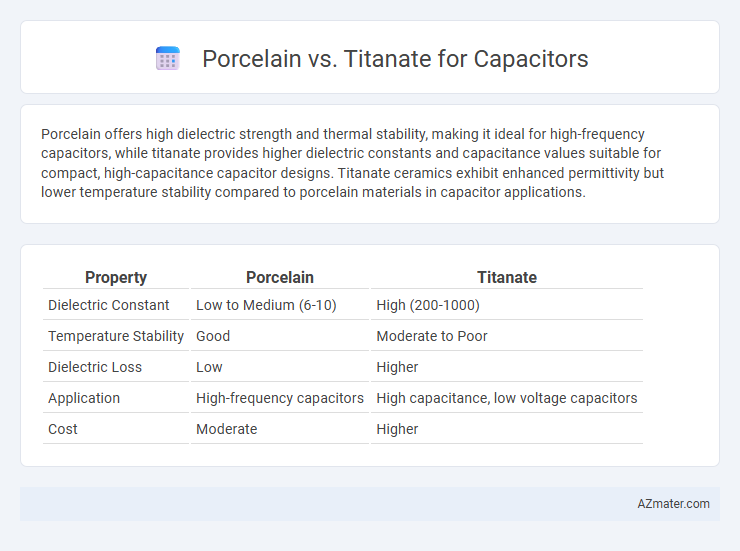Porcelain offers high dielectric strength and thermal stability, making it ideal for high-frequency capacitors, while titanate provides higher dielectric constants and capacitance values suitable for compact, high-capacitance capacitor designs. Titanate ceramics exhibit enhanced permittivity but lower temperature stability compared to porcelain materials in capacitor applications.
Table of Comparison
| Property | Porcelain | Titanate |
|---|---|---|
| Dielectric Constant | Low to Medium (6-10) | High (200-1000) |
| Temperature Stability | Good | Moderate to Poor |
| Dielectric Loss | Low | Higher |
| Application | High-frequency capacitors | High capacitance, low voltage capacitors |
| Cost | Moderate | Higher |
Introduction to Capacitor Dielectrics
Capacitor dielectrics such as porcelain and titanate play crucial roles in defining electrical properties, stability, and efficiency. Porcelain offers excellent mechanical strength and high dielectric constant but tends to have higher dielectric losses compared to titanate materials like barium titanate, which exhibit superior dielectric permittivity and temperature stability. The choice between porcelain and titanate dielectrics impacts capacitor performance parameters such as capacitance density, insulation resistance, and operational frequency range.
Overview of Porcelain Capacitors
Porcelain capacitors are ceramic capacitors that utilize porcelain as their dielectric material, offering excellent mechanical strength and high insulation resistance. They exhibit stable capacitance with low loss at high frequencies, making them suitable for radio frequency (RF) applications and precision circuits. Their robust thermal and electrical properties provide reliable performance in environments with varying temperature and voltage conditions.
Overview of Titanate Capacitors
Titanate capacitors utilize barium titanate as the dielectric material, offering high dielectric constants that enable compact capacitor designs with increased capacitance values. These capacitors typically exhibit lower losses and higher temperature stability compared to porcelain capacitors, making them suitable for high-frequency and high-precision electronic applications. Their exceptional dielectric properties provide improved performance in energy storage and filtering tasks within advanced electronic circuits.
Material Composition and Structure
Porcelain capacitors are composed primarily of ceramic materials such as alumina and silica, providing high dielectric strength and stability through a crystalline, microporous structure. Titanate capacitors utilize barium titanate (BaTiO3) as their dielectric material, characterized by a perovskite crystal structure that offers a high dielectric constant and enhanced temperature coefficient properties. The fundamental difference in material composition and crystal structure directly influences the capacitance, temperature stability, and application suitability of porcelain versus titanate capacitors.
Dielectric Properties Comparison
Porcelain capacitors exhibit a dielectric constant typically ranging from 6 to 15, offering excellent stability and low dielectric loss, making them suitable for high-frequency applications. Titanate-based capacitors feature a much higher dielectric constant, often exceeding 1000, which allows for greater capacitance in smaller volumes but may suffer from higher dielectric losses and temperature sensitivity. The key difference lies in titanate dielectrics providing enhanced capacitance density, while porcelain dielectrics ensure superior thermal and frequency stability.
Performance in High-Frequency Applications
Titanate capacitors exhibit superior high-frequency performance due to their lower dielectric losses and high dielectric constant, making them ideal for RF and microwave circuits. Porcelain capacitors, while robust and stable under mechanical stress, typically suffer from higher equivalent series resistance (ESR) and lower capacitance density, limiting their effectiveness at elevated frequencies. For applications requiring minimal signal distortion and fast charge-discharge cycles, titanate dielectric materials deliver enhanced efficiency and reduced noise interference.
Temperature Stability and Reliability
Porcelain capacitors exhibit excellent temperature stability due to their low dielectric constant variance, maintaining consistent capacitance across a wide temperature range of -55degC to 125degC. Titanate capacitors, with their high dielectric constant, offer superior capacitance but show less temperature stability, as their capacitance can fluctuate significantly between -40degC and 85degC. Reliability in porcelain capacitors is enhanced by their robust ceramic structure, making them ideal for high-temperature and high-reliability applications, while titanate capacitors may degrade faster under thermal stress due to their material composition.
Size, Cost, and Manufacturing Considerations
Porcelain capacitors generally offer compact size and moderate cost but face challenges in high-frequency applications due to their dielectric properties. Titanate capacitors, while typically larger and more expensive, provide superior dielectric stability and higher capacitance per volume, benefiting precision electronics. Manufacturing of porcelain capacitors involves well-established processes with lower material costs, whereas titanate capacitors require specialized fabrication techniques that drive up production expenses.
Typical Applications and Industry Use Cases
Porcelain capacitors are primarily used in high-frequency applications such as radio transmitters, RF circuits, and precision filters due to their stable dielectric properties and low loss characteristics. Titanate capacitors are commonly employed in power electronics, automotive systems, and industrial automation where high dielectric constant and temperature stability are critical for energy storage and voltage regulation. Both materials serve specialized roles, with porcelain favored for signal integrity and titanate for robust performance in harsh operational environments.
Choosing the Right Dielectric: Porcelain or Titanate?
Choosing the right dielectric between porcelain and titanate for capacitors depends on their dielectric constants and temperature stability; porcelain offers excellent insulation and mechanical strength with moderate dielectric constant, making it suitable for high-voltage applications. Titanate provides a higher dielectric constant and better capacitance in smaller volumes but may exhibit less temperature stability, ideal for compact, high-capacitance requirements. Understanding the trade-offs in dielectric properties, voltage rating, and application environment ensures optimal capacitor performance and longevity.

Infographic: Porcelain vs Titanate for Capacitor
 azmater.com
azmater.com